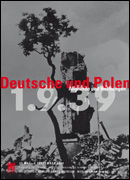


Exhibition | Oppression and Self-assertion | War and Occupation | Conflicts and Rapprochements
The Invasion
| Forced Labor
| Colonization, Deportation, Extermination
Genocide
| Resistance and Self-assertion
The End of the War
| Expulsion of the Germans
| Expulsion of the Poles
In October 1939, Germany annexed occupied Polish territories, forming new provinces: "Wartheland" and "Danzig/West Prussia". The Nazis then set about "Germanizing" these two provinces as fast as they could. Beginning in autumn 1939, the occupiers deported hundreds of thousand of Poles to the "General Government" in order to make room for German settlers living as minorities in the provinces east of the Reich.
The ideological objectives of the Nazi leadership went far beyond colonizing occupied Poland, however, and planning for the new Eastern European order began in 1941. Germany's "General Plan for the East" called for ethnical restructuring and "Germanization" of conquered territories. Over 30 million people, most of them from Poland and the Soviet Union, were to be sent to Siberia and resettled there. The death of millions of "racially undesirably" people was also a fixed component of the Nazi plan, as the war of annihilation took its course.
